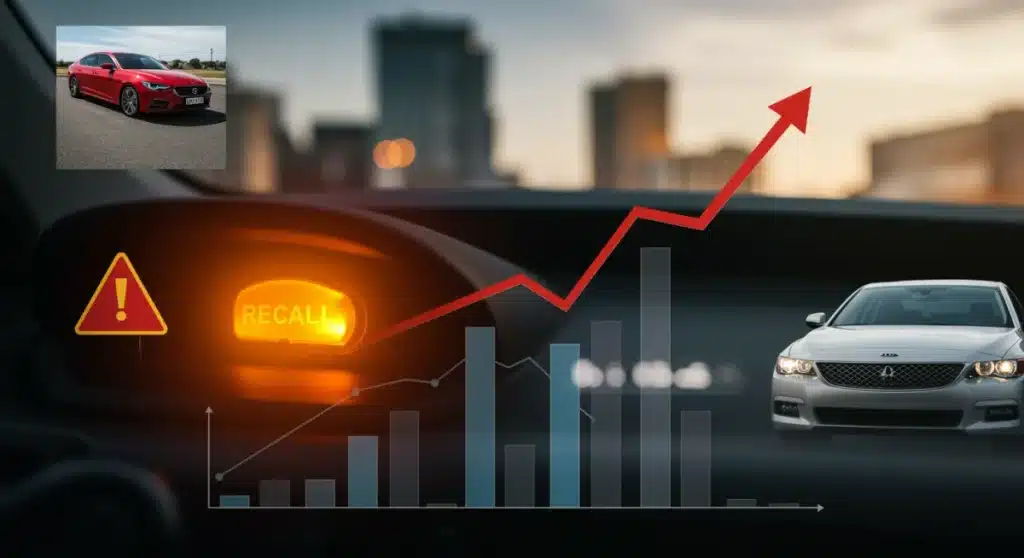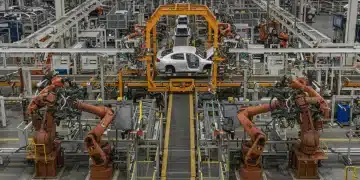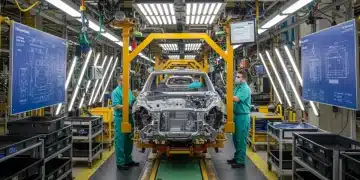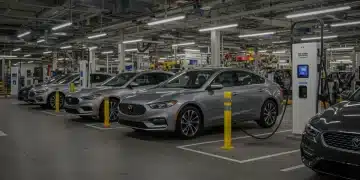US Auto Recalls: 15% Increase Analysis & Impact

The recent 15% surge in US auto recalls within the last six months demands immediate attention, revealing critical insights into manufacturing trends, regulatory oversight, and consumer safety implications across the United United States.
US auto recalls increase by 15% in the last six months, signaling a critical juncture for the automotive industry and consumers alike. This significant uptick prompts a detailed inquiry into the contributing factors, the specific types of defects emerging, and the broader implications for vehicle safety and manufacturer accountability.
Unpacking the 15% Surge in US Auto Recalls
The recent data from the National Highway Traffic Safety Administration (NHTSA) reveals a notable 15% increase in US auto recalls over the past six months, a trend that warrants immediate and thorough examination. This surge is not merely a statistical anomaly but reflects deeper systemic issues within the automotive manufacturing and supply chain, impacting millions of vehicles and their owners.
Understanding this increase requires looking beyond the raw numbers to the specific categories of defects and the regulatory environment. While an increase in recalls might initially sound alarming, it can also indicate a more proactive stance from regulators and manufacturers in identifying and addressing potential safety hazards before they lead to more severe consequences. However, the sheer volume suggests that underlying problems are becoming more prevalent or are being detected with greater frequency.
Key Drivers Behind the Recall Increase
- Supply Chain Complexities: Global supply chain disruptions have led to increased reliance on varied suppliers, sometimes resulting in components that do not meet original specifications or quality standards.
- Advanced Technology Integration: Modern vehicles are equipped with increasingly complex electronic systems and software. These sophisticated technologies, while enhancing features, also introduce new avenues for defects and vulnerabilities.
- Enhanced Regulatory Scrutiny: Regulatory bodies, particularly NHTSA, are stepping up their oversight, employing advanced analytics and data collection methods to identify potential recall campaigns earlier.
- Aging Vehicle Fleet: With vehicle ownership periods extending, older models are experiencing component failures that might not have been anticipated during initial design and testing.
The confluence of these factors creates a challenging landscape for automakers. They must navigate a complex web of global manufacturing, rapid technological advancement, and stringent safety expectations. The 15% increase underscores the continuous pressure on the industry to balance innovation with unwavering reliability and safety.
Common Defects Driving the Recall Numbers
A closer look at the types of defects contributing to the 15% rise in US auto recalls reveals recurring patterns, yet also new challenges. Traditional mechanical failures continue to be a concern, but a growing segment of recalls is now attributed to issues stemming from advanced vehicle technologies, including software glitches and complex electronic system malfunctions.
This shift highlights the evolving nature of automotive engineering and the diagnostic complexities involved in identifying and rectifying these modern issues. For consumers, understanding these common defects is crucial for recognizing potential warning signs and responding promptly to recall notices.
Prevalent Mechanical and Structural Issues
- Brakes and Steering: Issues related to braking systems (e.g., faulty ABS modules, contaminated fluid) and steering components (e.g., power steering assist failure) remain critical safety concerns.
- Airbag Systems: Despite past massive recalls, new defects in airbag inflators or sensor systems continue to emerge, posing significant risks in the event of a collision.
- Fuel System Components: Leaks or malfunctions in fuel lines, pumps, or tanks can lead to fire hazards or unexpected engine stalls.
Beyond these mechanical aspects, the increasing sophistication of vehicles means that electronic and software-related problems are becoming more frequent. These can range from minor annoyances to critical safety hazards, affecting everything from advanced driver-assistance systems (ADAS) to infotainment units that can distract drivers or fail to provide crucial information.
The detection of these defects often requires advanced diagnostic tools and a deep understanding of complex integrated systems, posing a challenge for both manufacturers and independent service centers. The data suggests that manufacturers are grappling with maintaining consistent quality control across all these intricate systems, leading to a higher incidence of recalls.
Regulatory Response and Industry Accountability
In response to the escalating number of recalls, particularly the 15% increase in US auto recalls, regulatory bodies like the NHTSA are intensifying their oversight. This enhanced scrutiny aims to ensure that manufacturers are not only identifying defects promptly but also implementing effective and timely remedies. The focus is on holding manufacturers accountable for vehicle safety throughout the product lifecycle.
NHTSA’s role extends beyond issuing mandates; it involves rigorous investigations, data analysis, and proactive measures to anticipate potential issues. This proactive approach, coupled with stricter enforcement, is a significant factor in the higher recall numbers, as issues that might have gone unnoticed or unaddressed in the past are now being brought to light.
NHTSA’s Enhanced Enforcement Measures
- Increased Investigations: More frequent and in-depth investigations into consumer complaints and accident data to pinpoint emerging defect trends.
- Data Analytics: Utilization of advanced data analytics to identify patterns and potential safety issues across vehicle models and manufacturers more efficiently.
- Fines and Penalties: Stiffer penalties for manufacturers failing to comply with safety regulations or delaying recall campaigns, pushing for greater adherence.
The automotive industry, in turn, is adapting to this heightened regulatory environment. Manufacturers are investing more in quality control, internal testing, and post-production monitoring. Some are even adopting predictive analytics to identify potential defects in components or systems before they manifest as widespread issues. This shift signifies a move towards more preventative measures, driven by both regulatory pressures and a desire to protect brand reputation.
However, the challenge remains substantial. The global nature of automotive production means that defects can originate from various points in the supply chain, making comprehensive oversight complex. The industry’s response to these recalls, including the speed and effectiveness of repairs, will be crucial in restoring consumer confidence and ensuring long-term safety.
Impact on Consumers: Safety, Costs, and Trust
The 15% increase in US auto recalls directly impacts millions of consumers, bringing forth concerns about vehicle safety, potential financial burdens, and eroding trust in automotive brands. For many owners, receiving a recall notice can be a source of anxiety, prompting questions about the reliability of their vehicle and the safety of their families.
Beyond the immediate safety implications, there are practical considerations. Scheduling repairs, arranging alternative transportation, and dealing with potential delays can be inconvenient and costly, even when the repair itself is covered by the manufacturer. This ripple effect extends to the resale value of vehicles and the overall perception of certain brands in the marketplace.
Consumer Concerns and Practicalities
- Safety Anxiety: Owners often worry about driving a potentially defective vehicle, especially if the recall involves critical safety components like brakes or airbags.
- Time and Inconvenience: The process of getting a recalled vehicle repaired can be time-consuming, requiring appointments and potentially leaving owners without transportation.
- Resale Value: A vehicle with multiple recalls, particularly those related to significant safety issues, can see a decrease in its resale value.

Consumer trust is a fragile commodity in the automotive industry. Frequent or poorly managed recalls can significantly damage a brand’s reputation, leading to decreased sales and customer loyalty. Manufacturers are increasingly aware that transparent communication, efficient recall processes, and genuine commitment to customer safety are paramount for maintaining consumer confidence.
Consumers are also becoming more informed, utilizing online resources and government databases to check for recalls on their vehicles. This increased awareness places additional pressure on manufacturers and dealerships to be proactive and customer-centric in their recall management strategies. The long-term impact on consumer purchasing decisions will depend heavily on how effectively the industry addresses these challenges.
Comparison with Historical Recall Trends
To fully grasp the significance of the 15% increase in US auto recalls, it is essential to compare it with historical recall trends. While recalls have always been a part of the automotive landscape, the current surge indicates a departure from typical fluctuations and may signal a new era of heightened vigilance and complex manufacturing challenges.
Historically, major recall spikes often followed significant technological advancements or widespread issues with a single component supplier, such as the infamous Takata airbag recall. However, the current increase appears to be more broadly distributed across various manufacturers and defect types, suggesting a more systemic rather than isolated problem.
Key Historical Context Points
- Post-Recession Quality Control: Following economic downturns, some manufacturers may have cut corners on quality, leading to delayed defect manifestation years later.
- Specific Component Failures: Past large-scale recalls often centered on a single, widely used component from a common supplier, such as ignition switches or specific tire models.
- Evolving Regulatory Standards: Safety standards have progressively tightened over decades, leading to a broader definition of what constitutes a recallable defect.
The current recall environment differs in its complexity. It’s not just about mechanical parts; it encompasses intricate software, interconnected electronic systems, and advanced driver-assistance features. This broader scope makes defect identification and resolution more challenging than in previous eras. The comparison reveals that while recall numbers fluctuate, the underlying causes are becoming more diverse and technologically driven.
This historical perspective underscores that the automotive industry is in a constant state of evolution. Each period brings its unique set of challenges and recall drivers. The current trend suggests that manufacturers must now contend with a more intricate set of variables, pushing for greater investment in research, development, and stringent quality assurance across all aspects of vehicle production.
Forecasting Future Recall Landscape and Prevention
Given the recent 15% increase in US auto recalls, forecasting the future landscape involves considering both ongoing challenges and potential advancements in prevention. The trend indicates that recalls are likely to remain a significant aspect of the automotive industry for the foreseeable future, driven by technological complexity and heightened consumer expectations for safety.
However, the industry is also investing heavily in advanced manufacturing techniques, artificial intelligence for quality control, and sophisticated diagnostic tools that could potentially mitigate future recall events. The balance between rapid innovation and robust safety validation will define the trajectory of recalls in the coming years.
Strategies for Recall Prevention
- Predictive Analytics: Utilizing AI and machine learning to analyze vast datasets from vehicle sensors and manufacturing processes to identify potential defect patterns before they become widespread.
- Enhanced Testing Protocols: More rigorous and comprehensive testing, including virtual simulations and real-world scenarios, for all new components and software.
- Supply Chain Transparency: Implementing stricter oversight and auditing mechanisms across the entire supply chain to ensure consistent quality from all component suppliers.
The future of recall prevention also lies in collaborative efforts between manufacturers, suppliers, and regulatory bodies. Sharing data, best practices, and lessons learned from past recalls can create a more resilient and responsive industry. For consumers, this could translate into safer vehicles and fewer inconveniences related to recall campaigns.
While the current surge in recalls presents challenges, it also serves as a catalyst for innovation in safety and quality. The industry’s ability to adapt, learn, and implement proactive measures will be crucial in shaping a future where the number of US auto recalls stabilizes or even declines, ensuring greater confidence in the vehicles populating our roads.
Key Aspect |
Brief Description |
|---|---|
Recall Increase |
US auto recalls jumped 15% in the last 6 months, impacting millions of vehicles. |
Main Drivers |
Complex supply chains, advanced tech, and enhanced regulatory scrutiny contribute to the surge. |
Consumer Impact |
Safety concerns, inconvenience, and potential impact on vehicle resale value are key consumer effects. |
Future Outlook |
Industry is focusing on predictive analytics and stricter quality control to prevent future recalls. |
Frequently Asked Questions About US Auto Recalls
The 15% increase is attributed to several factors, including increasingly complex vehicle technology, global supply chain issues affecting component quality, and heightened scrutiny from regulatory bodies like NHTSA. These elements combine to identify and address more defects than before.
While traditional mechanical issues like brake and steering problems persist, a growing number of recalls stem from advanced electronic systems and software glitches. Airbag system defects and fuel system components also remain significant contributors to the overall recall volume.
Owners face safety concerns, inconvenience from repair scheduling, and potential impacts on their vehicle’s resale value. It also raises questions about manufacturer trustworthiness, necessitating clear communication and efficient recall processes from automakers to maintain confidence.
NHTSA is intensifying its oversight through increased investigations, utilizing advanced data analytics to detect patterns, and imposing stricter penalties for non-compliance. Their focus is on ensuring manufacturers promptly identify defects and implement effective, timely remedies for vehicle safety.
Automakers are investing in predictive analytics, enhanced testing protocols, and greater supply chain transparency. These proactive measures aim to identify and rectify potential defects early in the production cycle, balancing rapid innovation with robust safety validation to reduce future recall events.
What this means
The recent 15% increase in US auto recalls underscores a dynamic and challenging period for the automotive sector. This trend highlights the critical need for continued vigilance from both manufacturers and regulatory bodies, emphasizing that innovation must always be coupled with unwavering commitment to safety. For consumers, staying informed about recall notices and understanding their implications is more important than ever. The industry’s ability to adapt to these challenges through advanced prevention strategies and transparent communication will ultimately define its path forward, ensuring safer roads and restoring confidence in modern vehicles.





